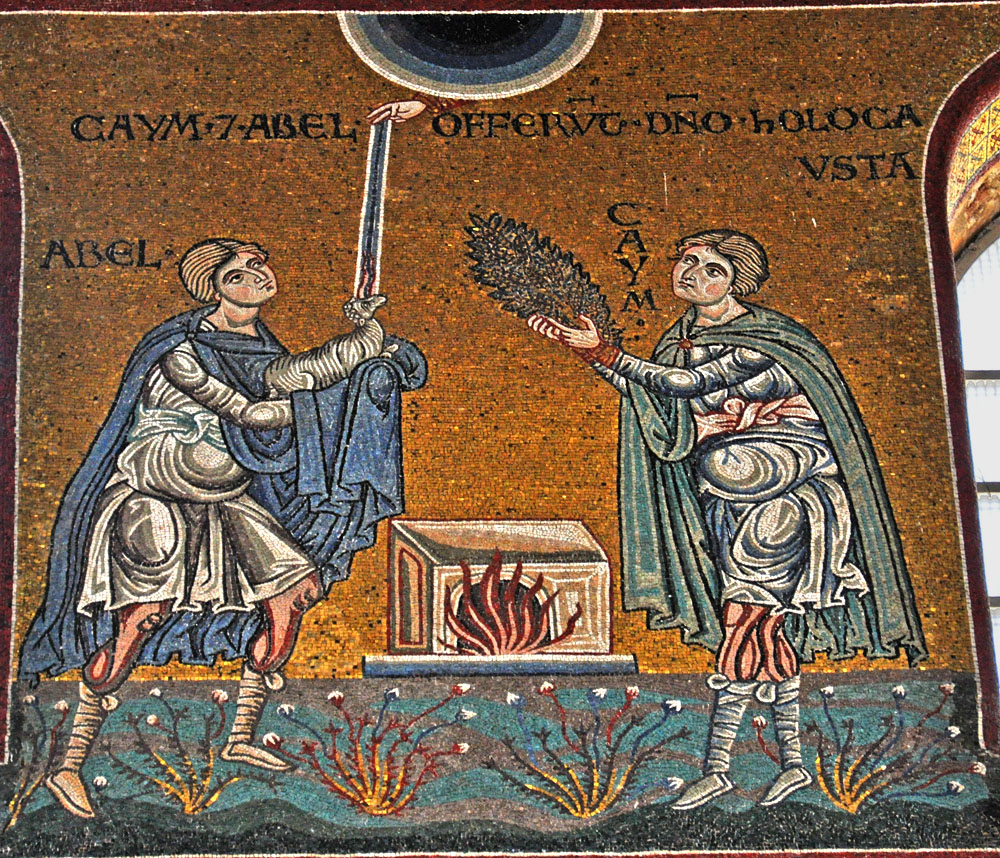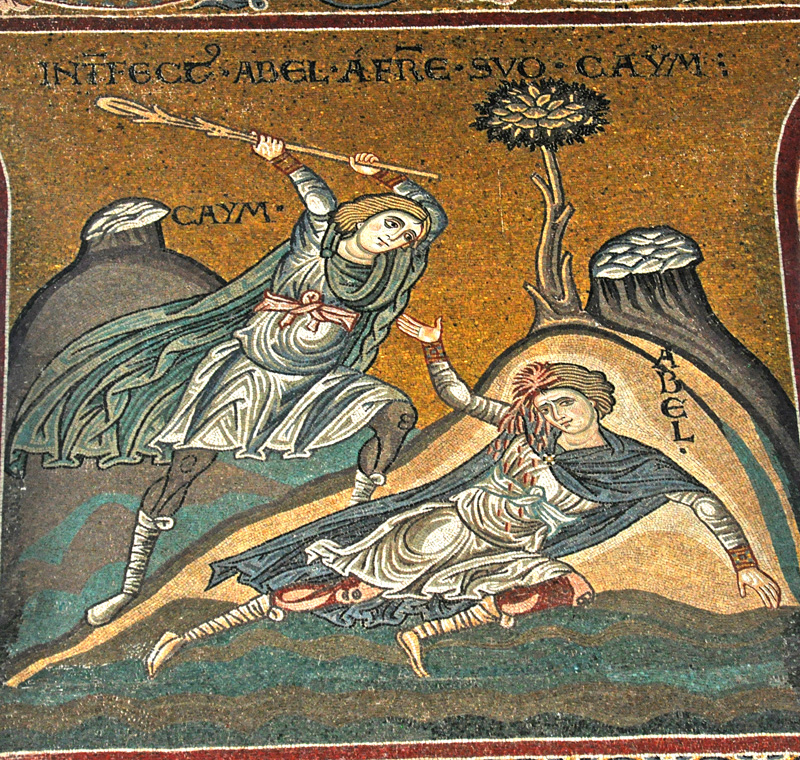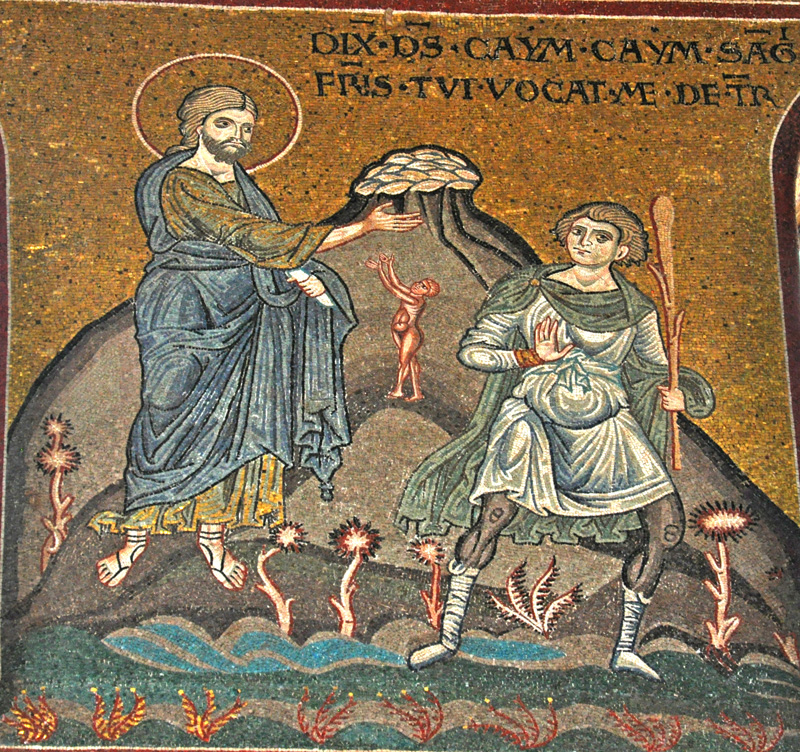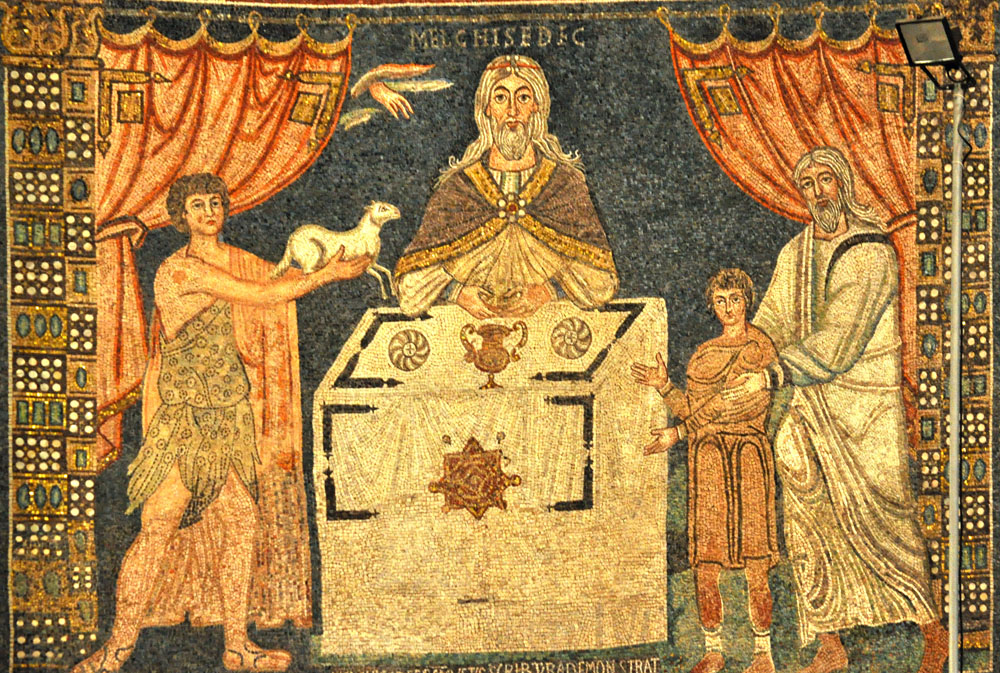The Two Sacrifices
The images and mystery plays picture God's discrimination between the two sacrifices by having fire come down on Abel's offering but not on Cain's (example). The fire was first proposed in the second century by Theodotion and cited in the fourth by St. Jerome and in the fifth or sixth by Procopius of Gaza. Jerome noted that the absence of fire on Cain's offering would explain how he could have known that God had rejected it, and he cited God's similar actions in the dedication of the Temple of Solomon and Elijah's discrediting of the prophets of Baal.1Why did God disdain Cain's offering? Genesis gives no answer, but Procopius of Gaza explains that what Abel gave, he gave entirely, while Cain selfishly divided what he had between God and himself – and took his time doing even that (example). Abel is thus rightly called pious and a lover of God, while Cain is a "philautos," a lover of himself.2 All the English mystery cycles have Cain allotting his poorer sheaves to God and the better ones to himself, and all dramatize his anger when God sends fire to Abel's offering but not to his own.3
In some images Cain slays Abel with a club formed from a tree branch, as in the second picture at right and this example. In others he uses an axe (example) or simply strangles him with his hands (example). Genesis 4:16-24 tells the rest of Cain's story. In verse 16 he lives as a "fugitive," but in 17 he takes a wife and builds a city that he names after his son, Enoch. Then the chapter lists the line of Enoch's descendants, ending in Lamech, who in the commentaries on verse 23 was said to have accidentally killed Cain while out hunting (image).6 This event was dramatized in the N-Town "Noah" (lines 143-198) and is illustrated in the Holkham Bible Picture Book (folio 6v).
Lamech's sons were Tubalcain, the inventor of metallurgy and thus of warfare, and Jubal, the first person to use musical instruments. They are pictured in the Genesis Relief at Orvieto Cathedral.
The Typology
Abel's Sacrifice and the Eucharist
From at least the 4th century Abel's sacrifice was memorialized along with those of Abraham and Melchizedech in the Eucharistic Prayer, the central section of the Christian liturgy:In your goodness, look upon these things with a peaceful and kindly regard. Accept them as you graciously accepted the gifts of your righteous servant Abel, the sacrifice of our patriarch Abraham and the offering of your high priest Melchizedek, a holy sacrifice and spotless victim.4Accordingly we will sometimes see images of the three sacrifices together, as in the picture above, or of just Abel and Melchizedech (example).
Abel a Type of Christ
As a shepherd who offered God a lamb, Abel was taken to be a type of Christ, the "Good Shepherd" (John 10:11,14) and "Lamb of God" (John 1:29).5 In the N-town "Cain and Abel" Abel associates the lamb he offers with Christ, who "in a lamb's likeness Thou shalt for man's wickedness…die full dolefully." I have not yet found any images or image juxtapositions suggestive of this typology, but there is an interesting illustration in a 14th-century manuscript, where the child Abel stands on his mother's lap and presses his face to hers just as the child does in Madonna and Child images derived from the Byzantine Parthenous Eleousa genre.
Prepared 2015-01-06 by Richard Stracke, Emeritus Professor of English, Augusta University.
HOME PAGE
Abel, Melchizedech, and Abraham, 7th century, Basilica of Sant'Apollinare in Classe, Ravenna.
OTHER IMAGES

The first of the three Cain-and-Abel panels at Monreale Cathedral, Palermo: Both brothers offer sacrifice, but only Abel's offering is accepted. See further details on the description page.

Second of the three panels: Cain murders Abel. See further details on the description page)

Third panel: God curses Cain. See further details on the description page.
MORE IMAGES
- 13th century: The story is told in mosaics at the left (south) end of the narthex of the St. Mark's Basilica, Venice.
- 1250-60: Manuscript illuminations on two facing pages in the Wenceslaus Psalter present the Genesis story from the Creation through the murder of Abel.
- 1310-31: In a bas-relief at Orvieto Cathedral, Cain's club is topped by three orb shapes, as if it were a whole tree in leaf.
- 1351-60: In a fresco in Pomposa Abbey the sacrifices of Cain and Abel are flanked by the sin of their parents on the left and the murder of Abel on the right.
- 1807-13: The Sacrifice of Abel on the west façade of Milan Cathedral.
NAMES
- Cain's name is sometimes spelled Caim or Caym
ALSO SEE
NOTES
1 Glossa Ordinaria, I, 114. For the fire at the dedication of the Temple, see II Chronicles 7:1. For the discrediting of the prophets of Baal, see I Kings 18:20-40.
2 Glossa Ordinaria, ibid.
3 For the Wakefield "Killing of Abel," lines 57-256 see Bevington, 277-82. Also see the Chester "Creation" lines 529-76 in Deimling, I, 41-42 and the N. Town "Cain and Abel" lines 92-134 in Cawley, 30-31. Presumably The York plays followed suit, but the manuscript is missing the pages where Cain and Abel make their sacrifices. See Davidson, 44.
4 This is my translation of the phrasing in the Gelasian Sacramentary (p. 235). This sacramentary established the canon of the Mass as used in Catholic churches from the 6th century till the 20th. It follows the consecration of the elements. The De Sacramentis, attributed to Ambrose and possibly from the 4th century, records an almost identical formula for the offering: "…we ask and pray that thou wouldst receive this oblation on thy altar on high by the hands of thy angels, as thou didst vouchsafe to receive the presents of thy righteous servant Abel, and the sacrifice of our patriarch Abraham, and that which the high priest, Melchizedek offered to thee" (VI, 27).
5 Cain on the other hand "signifies the people who killed Christ on Calvary." See Isidore of Seville, Allegoriae quaedam sacrae scripturae, §5, §6, and notes. Also see Mâle, 143.
6 The Glossa Ordinaria (I, 102) cites Rabanus Maurus: "The Hebrews say that Lamech lived so long that he went blind, and that he had a youth who guided him on his way. When he went hunting he pointed his arrow to where the youth indicated, and it happened that he killed Cain, who was lying in some bushes. And this is what he said [paraphrasing Genesis 4:23b] – 'I have killed a man in my wounding, (that is, by the wound that I caused). Not a beast but a man did I kill, so in my anger I killed the youth as well'" (my translation).
